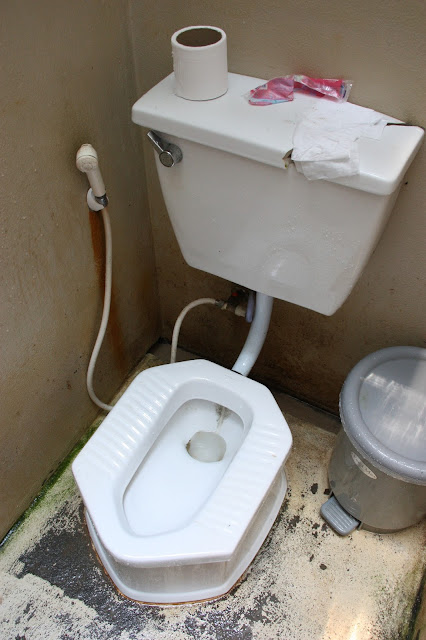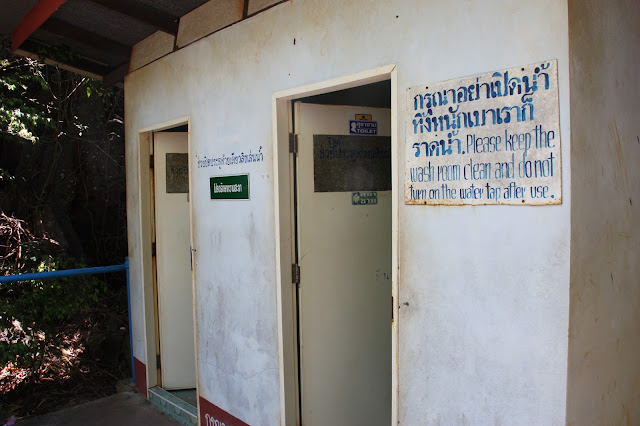Bangkok, Thailand is a sprawling urban jungle
of over nine million people. Located in southeast Asia, it is
infused with Theravada Buddhism, aggressive street hawkers, miles of
canals, and food vendors on nearly every alley in the city. Shanty
houses lie in the same neighborhood as luxurious skyscrapers.
Tuk-tuks and motorcycle taxis flood the streets. Everyone seems to
speak a little English, but no one seems to speak it fluently. In
short, the Thai capital, also known as Krung Thep, is like no other
city in the world.
The Chao Phraya River divides the city
of Bangkok and is a major venue for transportation. Not only do
tourists and locals use the river, but also large tugboats pulling
cargo.
Boat taxis run up and down the river,
making stops along the way. Some ferries, like this one, will simply
take you to the other side.
The most important (and busiest)
attraction in all of Thailand in the Grand Palace. Home to the Royal
family since 1782, the Grand Palace was constructed just fifteen
years after the former capital of Ayutthaya was destroyed by the
Burmese. It is visited by thousands of tourists and is home to the
Emerald Buddha.
In Thailand there is a strong alliance
between the Royal Family and the Buddhist religion. The king,
therefore, is greatly revered and his image can be found on many
public buildings and currency.
Khao San Road is one of the most famous
streets in Bangkok. It is popular for its cheap lodging and colorful
night market. Here one can get a massage, tattoo, eat bugs, or Pad
Thai. We went for the Pad Thai.
One of the most popular dishes in
Bangkok is a bowl of beef noodle soup. Some street stands specialize
only in noodle soup and you can buy a bowl for about 40 baht ($1.14).
Notice the bottled water in the
picture? Bangkok is a blazing hot city, yet tap water is not
potable. Bottled water is sold everywhere. So, stay hydrated!
In many respects, Bangkok is just like
Disneyland. Case-in-point are the boat taxis that transport
travelers up and down some of the main canals. A ride on one of
these boats can cost as low as 7 baht. A cruise along the waters will
make you forget that you are in a city full of skyscrapers, and
instead, take you away to the jungle, where palm trees hang over the
canals and shanty houses with clothes hanging to dry along the water's
edge.
And then there are the tuk-tuks, the
three-wheeled taxis that are ubiquitous in Bangkok. Once again, they
feel like a ride at Disneyland. But beware! Everywhere you go,
drivers will come up to you and ask: “tuk-tuk, tuk-tuk?” They
are wily. Always negotiate a price before accepting a ride. And
always be ready for an impromptu adventure.
For a less adventurous, yet more scenic
mode of transportation, try Bangkok's BTS, or Skytrain, system. The
BTS allows you to see the city from an elevated perspective, and lets
you sit in air-conditioned ease while avoiding the gnarly traffic
jams on the street. There are two lines, which don't allow for many
options, but if your destination falls near a BTS line, I would
definitely take it.
If the BTS doesn't meet your itinerary
needs, maybe the MRT, or subway, will. Although there is only one
line, it makes a long snaking path across the city.
The bus is another option in Bangkok.
If you can master the transit maps, they can take you almost
anywhere, and are very cheap. Some buses, like this red one, don't
have air-conditioning.
When in Thailand, you must make time
for a traditional Thai Massage. They will twist you, pull you, walk on you, dig their elbow in you, and make you cringe and almost cry, but when all is over, you will feel far better than when you arrived. Allow
one to two hours. My one hour massage cost 250 Baht
($7.13), plus a tip.
The national sport of Thailand is Muay
Thai boxing. As far as I know, there are two main venues in Bangkok,
with fights three times a week. Admission can be steep, ranging from
1000 to 2000 baht per person. Beware of pushy hawkers trying to sell
you the expensive seats. We didn't get to watch a fight on this
trip, but came across this training ring while on a walk.
Yes, the toilets in Thailand are
different than those in the States. There will be a variety in
Bangkok, as you probably wont find some of the more “deplorable”
ones that you may find elsewhere. You may encounter squat toilets,
but most of them will be sit-down type. They ask you not to put
toilet paper in the toilet as their plumbing system may not be able
to handle it. Instead, use the hose and sprayer to clean yourself
off; pat dry with toilet paper (if they have any), and you will be
good to go!
Bangkok is a museum of holy Buddhist
shrines and temples. Wat Pho, officially called Wat Phra
Chetuphon Vimolmangklararm Rajwaramahaviharn, dating back to the
17th century, was a royal monastery while the Grand Palace
was under construction. Replete with pagodas, ornate buildings,
Buddhas, and Chinese stone statues, Wat Pho is the quintessential
Thai temple.
The centerpiece of Wat Pho is the
Reclining Buddha. This forty-six meter icon is revered by many who
believe that worshiping the image will bring them peace and
happiness.
Across the city on the fringes of
Chinatown, the temple of Wat Traimit houses the largest golden Buddha
in the world.
When you visit a Thai temple, it will
be required of you to dress modestly (no shoulders or knees showing),
and when entering the holiest shrines of the Buddha, you must
remove your shoes.
During your visit, you will undoubtedly
happen upon monks dressed in their orange robes. I didn't learn much
about them during my visit, but they are certainly a curiosity.
Buddhists don't have a monopoly on
religion in Bangkok. You will find Muslims also, and they worship in
mosques such as this one. The Ton Son Mosque was originally built
around 1688 AD, but has since been renovated with modern materials.
Throughout Bangkok (as well as
Thailand), you will find spirit houses in front of many of the
properties. A spirit house is designed as a place for spirits to
dwell that could cause problems for the property owners, especially
since their old home was disturbed by construction on the property.
It is usually in the shape of a house or temple, and offerings such
as flowers or food are often left.
Bangkok is world renowned for its
markets. Klong Toey is a fresh produce market that is best enjoyed
in the morning. Walking through this market you will find Thai chili
peppers, tamarind, long beans, morning glory, pulsating fish, mounds
of raw meat, huge balls of curry, and any other ingredients that you
would find in Thai cooking.
Much different is the Pak Klong Talad
flower market, the largest of its kind in Bangkok. We visited here
in the evening, after dark, but they say the best time to come is
after midnight, around three in the morning when the freshest floral
arrangements are being set out. Walking along Pak Klong Talad is a
sensory pleasure, with pleasant aromas swimming the air, and a
vibrant array to please the eye.
Next door is the Saphan Phut Night
Bazaar, near Memorial Bridge, and along the flank of the Chao Phraya
River. The later in the night you come, the more active the market
becomes. They sell t-shirts, jeans, DVD's, and about anything else a
teenager might want. It is here that I bought a jersey of my favorite
soccer team, Barcelona, for just a fraction of what I would have paid
in Spain.
On the weekend (and usually located an
hour or two outside the city) are the floating markets. A
combination of boats selling produce, and stalls on terra firma
selling meals, a floating market is the perfect place to experience a
new variety of food and setting. Fish is plentiful, and a common
meal will include the entire fish with a plate of rice and a spicy
dipping sauce.
It was here that I bought my first bag
of coconut water. Yes, they sell it in a bag with an insterted straw.
The biggest market in Bangkok is the
Chatuchak weekend market. Composed of over 8,000 stalls, Chatuchak
is almost too big to take in. Everything is sold here from art to
clothing to food to bugs (the edible kind).
If a crowded street market in the balmy
air of Bangkok doesn't sound appealing, how about one of its many
air-conditioned malls? We chose to relax at CentralWorld, sipping
on fruit shakes while sitting in cushy chairs. CentralWorld is
several stories high, and is the largest mall in Bangkok, with over
500 stores and 100 restaurants.
Around the corner from CentralWorld is
Siam Plaza, not a true plaza in the conventional sense of the word,
but a cluster of shops and restaurants. It is also a central hub of
traffic, with the BTS rail line directly above the street, and is
extremely busy with pedestrians.
Perhaps because of the abundance of
street stalls, the common grocery store isn't as common in Thailand
as it is in the States. The 7-Eleven store is the closest and most
convenient substitute we found. Not only is it very air conditioned, but it also sells some of those small knick-knacks that you may not find
anywhere else: finger nail clippers, band-aids, sim cards, and
toothpaste. We also enjoyed the pre-packaged, yet unique pastries such as bread with pandan cream spread on top. 7-Eleven is
found in nearly every neighborhood in Bangkok.
If you want to leave the chaos without
leaving the city, try a visit to Lumphini Park, Bangkok's own version
of Central Park in New York City. Here you will find lots of grass,
as well as ponds, and a panoramic view of the high-rise skyline.
There are peddle boats you can rent for a small price that will allow
you a romantic cruise on the lake. You will likely see a monitor
lizard or two.
Finally, no trip to Bangkok would be
complete without a trip to Chinatown, perhaps the largest in the
entire world. The principal street is Yarowat Road, with its gold
shops, street stalls, and lively night life. All the streets
radiating from Yarowat are equally alive, some in alleyways so narrow
that wandering through the overflowing merchandise can be a tricky
ordeal.
Don't be surprised if you come across
quivering fish heads, the smell of ancient Asian herbs, or a Chinese
Buddhist temple.
Whenever you're in Bangkok, the time
will come every evening when the large equatorial sun dips low on the
horizon of haze and smog, and after a glorious sky of amber-painted
colors, the night will come and take the edge from the heat. The
lights will turn on from the skyscrapers, the street stalls, the
tuk-tuks, the barges on the river, and a new chapter will begin on
your visit to Bangkok. ♠






































































